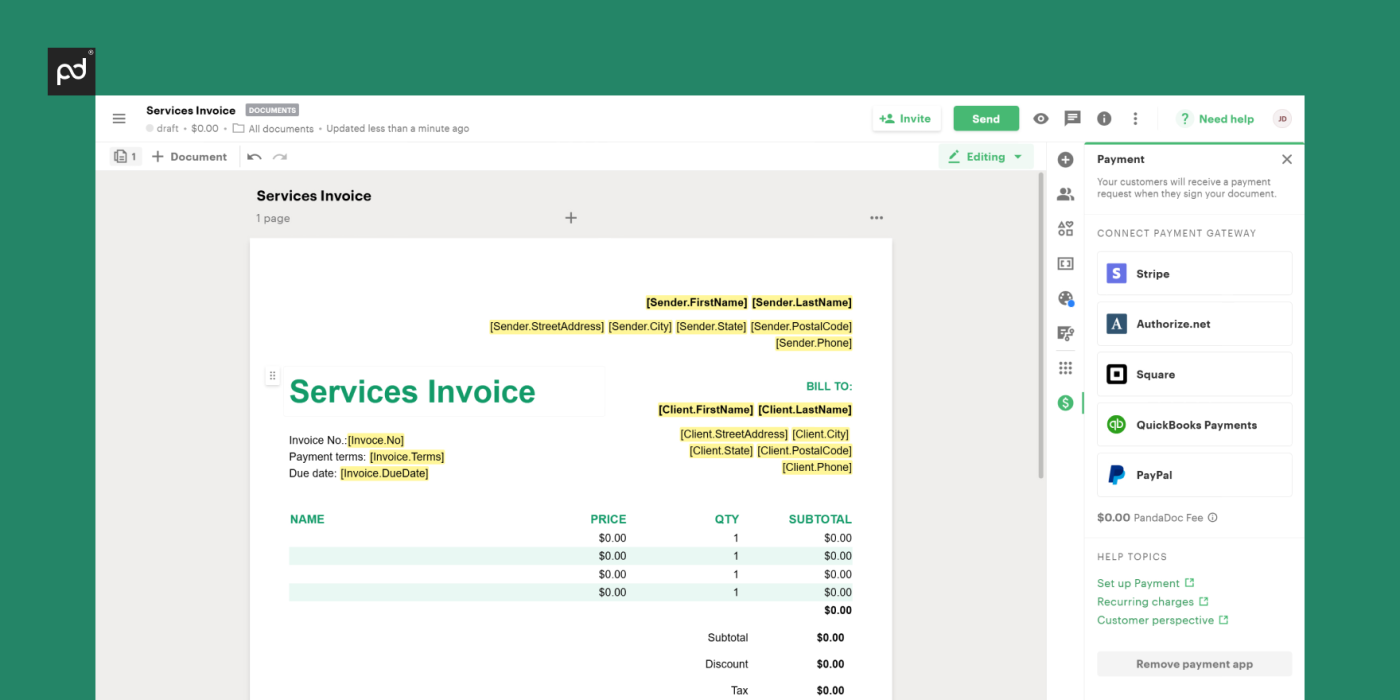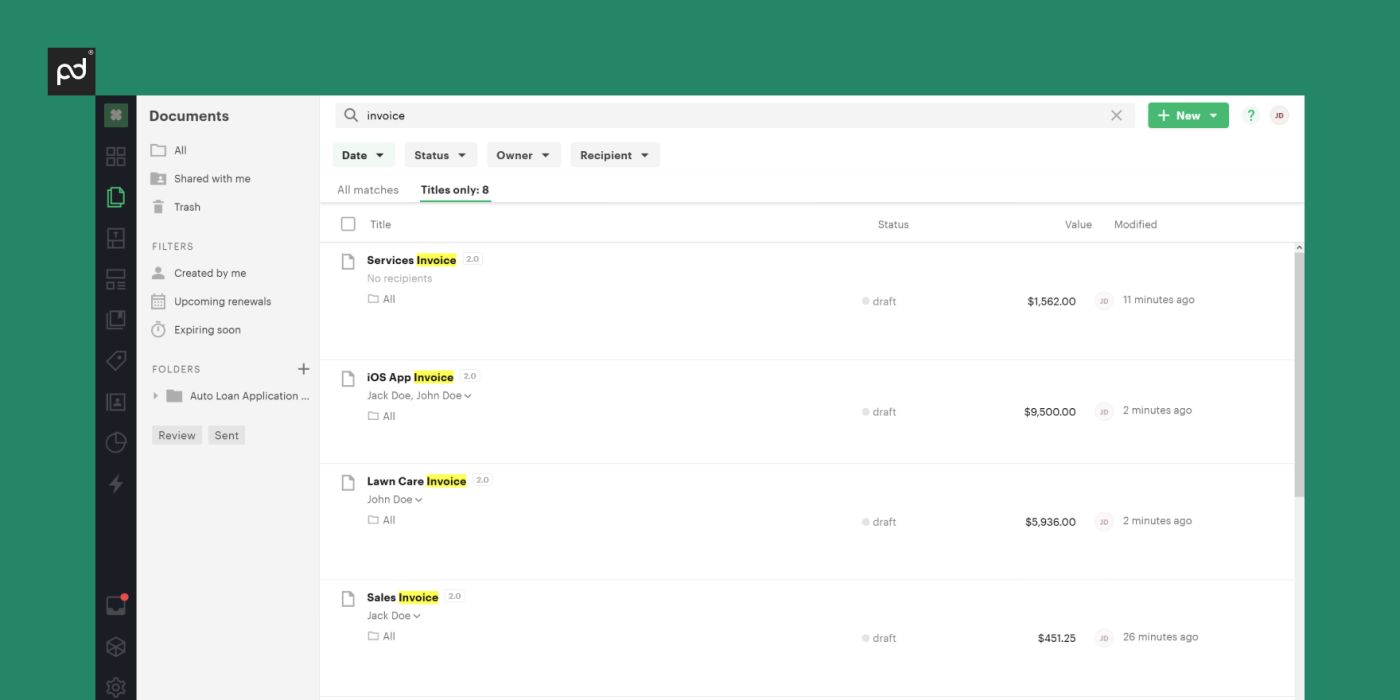How to send an invoice through email
The best way to send an invoice through email is to use dedicated sales invoicing software that enables you to make sure your clients receive and process their invoices on time.
Alternatively, you can simply write a brief email describing the services invoiced, include the invoice number in the subject line, attach the invoice as a PDF and make sure you send everything to the right person or department.
Read on to find out what the best practices for emailing invoices are.
1. Respect the invoicing schedule you’ve agreed on with your client
The first rule is to make sure you stick to the terms of the agreement you’ve signed with your client.
If you’re unsure, a simple double-check of the contract should be sufficient.
In the absence of a formal contract, an email can also be considered legally binding, but you need to make sure that it meets the typical requirements of a contract.
If you’re supposed to send an invoice at the end of each month, make sure you send it by the end of the month — not a week later.
Respecting invoicing terms is one of the things that makes you a reliable supplier and partner and enables your clients to stick to their monthly and quarterly budgets.
2. Make sure the invoice contains all the necessary information
There are a number of elements each invoice should contain, such as:
- An invoice number
- Issuing date
- Due date (payment deadline)
- Business name of your company and the client’s company
- Your business address
- Your client’s address
- Payment terms and details (due date, bank account information, penalties for late payments)
- Contact information (phone number, email address, etc.)
- A description of the invoiced items
- Discounts (if any)
- Other charges, e.g. shipping, taxes, packaging
- Total amount due
Use an invoice template to make sure you’ve included all the essentials.
For more information, check out our detailed guide on what an invoice is and how to create one.
3. Include information about the invoice in the email
Don’t just send a blank email with a PDF — this looks suspicious and you risk having your email end up in your client’s spam folder (or simply ignored).
Instead, in the body of the email, write a brief description of the goods or services they purchased, the purchase order number, if applicable, and make sure your subject line contains the essentials.
PandaDoc tip: If you’re issuing monthly invoices, we advise you to include the month and your company’s name in the subject line to make your clients’ lives easier.
This way, they can quickly find the right invoice later, without going through each invoicing email you’ve sent.
Here’s a quick email invoice template you can use:
Subject: Invoice #12345 – [month, year] – [your company name] for [brief description of goods or services provided]
Dear [client name],
Please find attached [your company name]’s invoice #12345 for [product/service], due on [payment due date]. If you have any questions, please don’t hesitate to reach out to us.
Thank you for your business!
Best regards,
[Email signature including your name, role, and company]
And, of course, double-check the attached invoice — confirm that you’ve correctly attached it and that it’s the right file.
To streamline all this, you can use a dedicated sales invoicing software such as PandaDoc, where you set up your own email and invoice templates.
This enables you to make sure all documents are uniform and consistent — and that they reach the right person.
4. Use a payment integration
One of the best ways to get paid faster and make things more convenient for your client (and for yourself) is to use a payment integration.
This allows clients to pay the invoice by clicking a link on it, which takes them to a secure online payment gateway where they can pay via credit card or with PayPal.
PandaDoc features an integrated payment system that enables you to automate payment collection.
This helps lower payment time to two days and enables your clients to pay you anytime, from any device (and avoid late fees).
The platform offers a large choice of payment integrations to help any small business find the best option for them and their clients.

5. Make sure you send the email to the right person or department
Nothing’s worse than waiting to receive payment for your invoice only to realize after the due date that you’ve sent it to the wrong person — and have to resend it and wait again.
Sending an invoice through email typically means someone in accounting or finance needs to open that email — if you’re the least bit unsure which address to use, check with your client for specific instructions.
6. Keep a record of all invoices and their status
And, lastly, track all invoices and their status, such as sent, paid, or overdue — and store all documents safely and securely for future reference.
Record payment reminders, too.
As a rule of thumb, you should do that for at least a couple of years, depending on your local tax laws, but it’s a good idea to store them for as long as possible.
Again, you can automate this part if you use a platform that enables you to send and track invoices, stay on top of all due dates, and quickly send follow-up invoice emails if needed.

Bonus tip: Use an invoice template to send invoices via email quickly and easily
Invoice templates help companies save time and efforts and also enable them to provide a better experience to their clients.
At PandaDoc, we offer ours for free — so that any freelancer, small business owner, or startup can send invoices quickly and conveniently and make sure they receive their payments promptly.
If you’d like to take your invoicing game to the next level and want to scale your business, it’s a good idea to automate and streamline all document-creation processes, including invoicing, and make sure your clients always receive and see your invoices — and can pay them quickly and easily.
With the right online invoicing software platform, it’s incredibly easy to build a well-oiled invoicing system that never fails you — and it helps you collect all payments with zero hassle.
Start 14-day trial of PandaDoc today.